Fusariosis is a fungal disease that garden crops are susceptible to. Fusarium-resistant varieties listed below boast increased resistance to other viral or fungal diseases. Based on the locality, some are able to produce larger or smaller crops. The listed varieties need the classic regime of watering and top dressing.
Content
What peppers are resistant to fusarium wilt
The breeding method of growing and natural resistance to fusarium wilt make these varieties suitable candidates for planting in each garden plot. The disease itself is insidious:
- detection is possible only at the middle stage of development;
- the fungus blocks communicating channels with organic substances;
- the plant is not able to photosynthesize and develop normally;
- Fusarium fungus is transmitted through agricultural machinery and plant waste, where it is stored for up to 3 years;
- the plant cannot be cured, it only needs to be dug up and burned.
Therefore, Fusarium is an undesirable guest in the garden of any summer resident. Breeders bred pepper varieties resistant to fusarium wilt.
Cowhide Ear
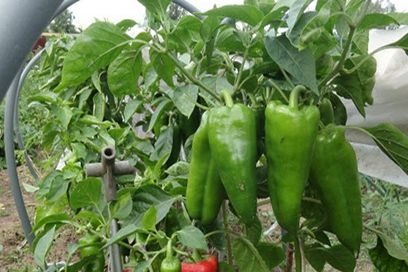 The cow’s ear is a sweet pepper variety that is quite demanding in its content, but resistant to an impressive number of diseases. In addition, taste is considered a pleasant bonus: the pulp does not have a bitter aftertaste even at the stages of technical maturity. This pepper can be freely considered as candidates for fresh and pickled form. Maturity is determined by color. Fruits gradually change from saturated green to dark shades of red. The weight of one ripe pepper is 200 grams, a crop of 1 sq. M reaches 3 kilograms.
The cow’s ear is a sweet pepper variety that is quite demanding in its content, but resistant to an impressive number of diseases. In addition, taste is considered a pleasant bonus: the pulp does not have a bitter aftertaste even at the stages of technical maturity. This pepper can be freely considered as candidates for fresh and pickled form. Maturity is determined by color. Fruits gradually change from saturated green to dark shades of red. The weight of one ripe pepper is 200 grams, a crop of 1 sq. M reaches 3 kilograms.
Darina
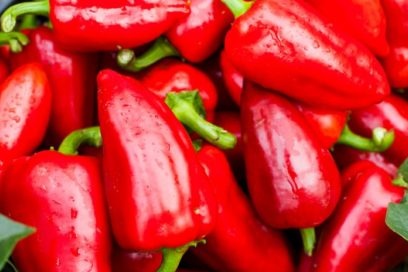 In addition to resistance to fungal diseases, Darina is able to bear fruit and grow in adverse temperature conditions. The plant itself is low, half-stemmed, grows up to 50-55 cm. Peppers weighing 100 grams and walls 6 mm ripen. During the technical maturity period it is colored in yellow, in biological it comes to red.
In addition to resistance to fungal diseases, Darina is able to bear fruit and grow in adverse temperature conditions. The plant itself is low, half-stemmed, grows up to 50-55 cm. Peppers weighing 100 grams and walls 6 mm ripen. During the technical maturity period it is colored in yellow, in biological it comes to red.
The variety is suitable equally for cultivation both in soil in the air, and in the closed greenhouse. Fertility with 1 square. m 6 kilograms. Darina is also immune to verticillosis.
Dobrynya
 The variety Dobrynya, befitting the name, is resistant to the list of diseases, including fusarium. The weight of one ripe vegetable is 100 grams, in the context of the thickness reaches 5 millimeters. Peppers are formed in the form of a prism, red in maturity. Experienced summer residents are advised to grow Dobrynya in the garden, rather than in a film greenhouse.
The variety Dobrynya, befitting the name, is resistant to the list of diseases, including fusarium. The weight of one ripe vegetable is 100 grams, in the context of the thickness reaches 5 millimeters. Peppers are formed in the form of a prism, red in maturity. Experienced summer residents are advised to grow Dobrynya in the garden, rather than in a film greenhouse.
The variety ripens early, gives fruit 95 days after the sprouts have fully risen. Dobrynya has a fixed yield of 13 kilograms per sq.m.
Beglitsky
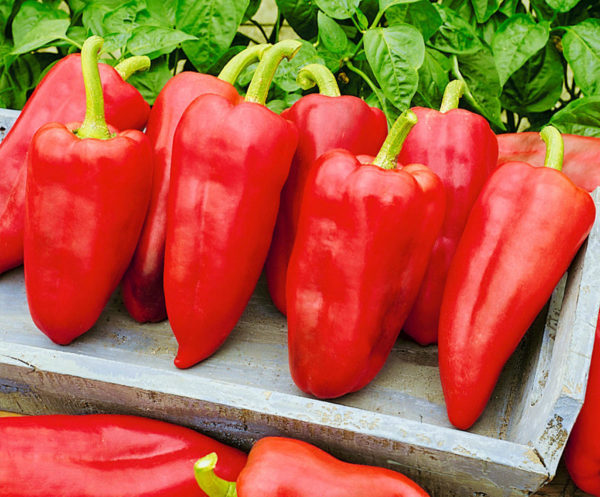 A type of pepper that produces fruits that are similar in appearance to a cone, which are colored red in biological ripeness. In addition to fusarium, it is immune to alternariosis and tobacco mosaic. The plant is low, reaches up to 75-85 cm. The fruits are still, well transported, weighing up to 70 grams. Beglitsky refers to varieties that are grown equally successfully in greenhouse conditions and in open ground. The wall thickness of the mature fetus is 4-5 cm.
A type of pepper that produces fruits that are similar in appearance to a cone, which are colored red in biological ripeness. In addition to fusarium, it is immune to alternariosis and tobacco mosaic. The plant is low, reaches up to 75-85 cm. The fruits are still, well transported, weighing up to 70 grams. Beglitsky refers to varieties that are grown equally successfully in greenhouse conditions and in open ground. The wall thickness of the mature fetus is 4-5 cm.
Hercules
Hercules is a late-ripening variety of pepper that turns bright red as it ripens. Peppers grow cuboid with rounded corners, wall thickness 5-7 mm. Before fruiting, 135-145 days will pass from the time of sprouting. Many experienced summer residents praise the variety for taste and widespread use for culinary purposes. The squat bush of Hercules is not high and not spreading, reaches only 50 cm.To match the name, the variety is very strong and resistant not only to diseases, but also to weather vagaries. Therefore, pepper of this variety can be grown in places not with the most favorable climate. But it’s better to avoid too open areas where strong seasonal winds blow.
Bulgarian
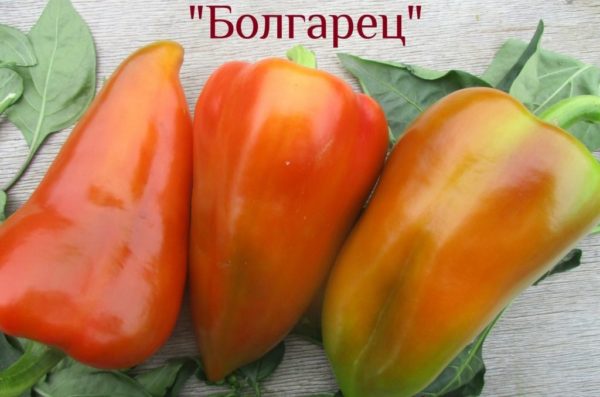 Bulgarian belongs to peppers with an average ripening period, gives fruits within 130 days from the germination of shoots. They are cone-shaped, weighing 150-200 grams and with a wall thickness of 5-7 mm. You can grow Bulgarian in a film greenhouse and open ground with the same yield indicators.
Bulgarian belongs to peppers with an average ripening period, gives fruits within 130 days from the germination of shoots. They are cone-shaped, weighing 150-200 grams and with a wall thickness of 5-7 mm. You can grow Bulgarian in a film greenhouse and open ground with the same yield indicators.
Within the limits of mass cultivation, it gives a yield of 50 tons per hectare. The Bulgarian is resistant, in addition to fusarium, to alternariosis. In biological ripeness, it reaches a red tint and has a glossy finish.
Rostov Jubilee
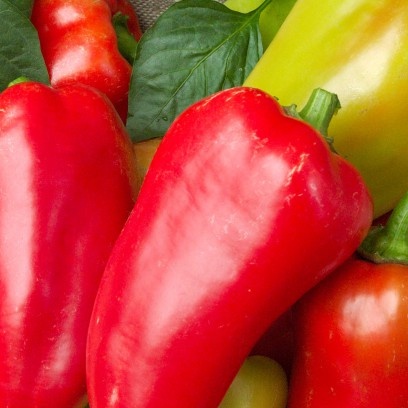 Mid-season variety of pepper, which is most favorably planted in open ground. The period between biting stems and ripening peppers 115 days. The wall thickness of one Rostov Jubilee 4-5 mm, weight - 120 grams.
Mid-season variety of pepper, which is most favorably planted in open ground. The period between biting stems and ripening peppers 115 days. The wall thickness of one Rostov Jubilee 4-5 mm, weight - 120 grams.
In a state of technical ripeness, the pepper turns pale green, and in the biological transition to red. It is widely used in the household: fresh and for conservation.
Jack
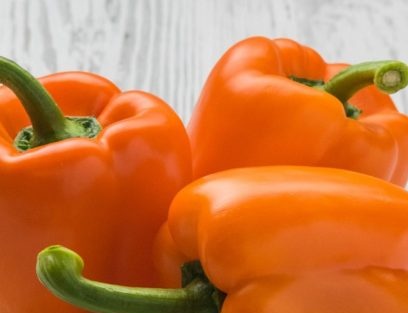 An early ripe variety of sweet pepper Jack bears fruit already by 105-110 day of planting. It grows in a greenhouse as well as in open ground. The bush is formed low, reaching the total growth - 55-60 cm. The yield of the variety is normalized, it is possible to get 5-6 kilograms of pepper from 1 sq. M plot.
An early ripe variety of sweet pepper Jack bears fruit already by 105-110 day of planting. It grows in a greenhouse as well as in open ground. The bush is formed low, reaching the total growth - 55-60 cm. The yield of the variety is normalized, it is possible to get 5-6 kilograms of pepper from 1 sq. M plot.
Jack stands out with his atypical orange color in a state of biological ripeness. Ripe pepper on a scale shows a value of 150-200 grams.
Sweet everest
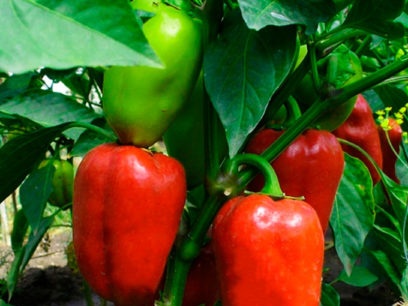 Despite the loud name, this variety does not differ in height, the bush is average: 40-45 cm and not sprawling. The mass of the fruit reaches 150-200 grams, and the total fertility per hectare is estimated at 160-400 centners, depending on the growing conditions.
Despite the loud name, this variety does not differ in height, the bush is average: 40-45 cm and not sprawling. The mass of the fruit reaches 150-200 grams, and the total fertility per hectare is estimated at 160-400 centners, depending on the growing conditions.
Peppers are equally used for marinade, salads and other culinary ideas. The walls differ in thickness, can reach 9 mm.
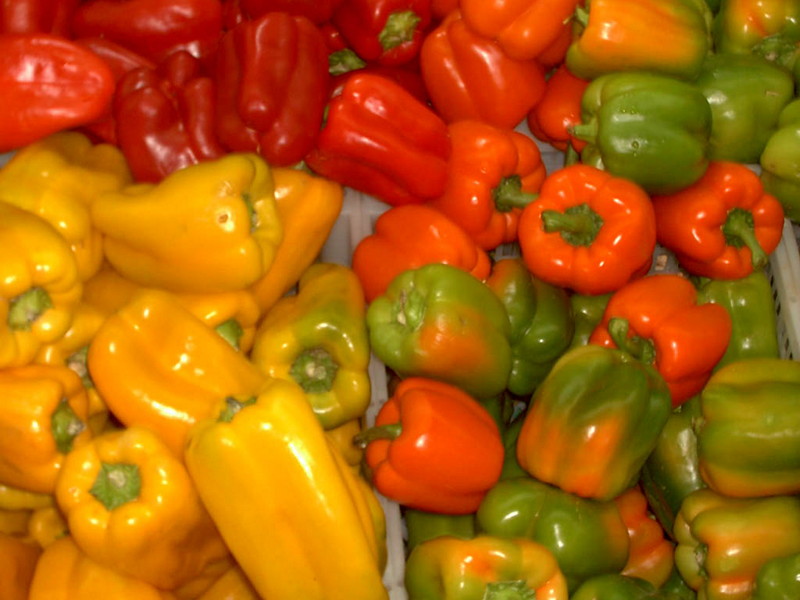 You may be interested in:
You may be interested in:Gift of Moldova
The fruitful type of pepper gives up to 7 kilograms per 1 sq. Meter of plantings. Ripening average. The gift of Moldova gives ripe fruits to 115-130 days after landing in the ground. The variety is suitable for cultivation in greenhouse conditions and in the garden.
The bush grows small, up to 50 cm. Sweet peppers grow in the shape of a cone, weighing 100-120 grams each. A typical wall size is 5 mm in thickness. It grows at a temperature not lower than 20 degrees.
Jeanne
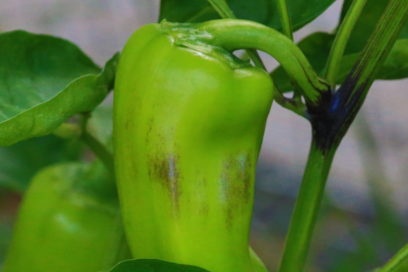 Treat the ripe varieties of peppers - 106 days. It grows well under film conditions and in open ground. The height of the plant is average 40-50 cm. The bush is compact and fits 15 fruits on itself. Their shape is similar to an elongated cone, the texture is glossy, smooth. In the process of growth, it has a light green color, the ripened fruit is dark red in color. The size of the walls is 8-9 mm. The weight of one pepper is 90-100 grams.Jeanne variety is universal and can be used for preparing any dishes. The taste quality is high, but the aroma is poorly expressed.
Treat the ripe varieties of peppers - 106 days. It grows well under film conditions and in open ground. The height of the plant is average 40-50 cm. The bush is compact and fits 15 fruits on itself. Their shape is similar to an elongated cone, the texture is glossy, smooth. In the process of growth, it has a light green color, the ripened fruit is dark red in color. The size of the walls is 8-9 mm. The weight of one pepper is 90-100 grams.Jeanne variety is universal and can be used for preparing any dishes. The taste quality is high, but the aroma is poorly expressed.
Fusarium is a dangerous disease that cannot be treated. therefore when choosing a variety of pepper, it is worth considering this fact. Fortunately, there are a lot of resistant varieties, they are unpretentious and seamlessly grow in any suburban area. And proper soil care and preventative measures will keep the crop.

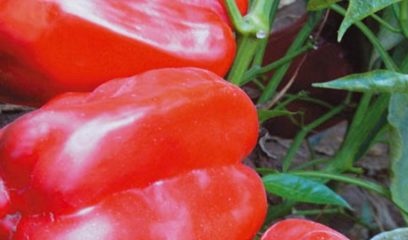



 Calorie pepper stuffed with meat and rice - BZHU per 100 grams
Calorie pepper stuffed with meat and rice - BZHU per 100 grams Gorky pepper - the best varieties for open ground
Gorky pepper - the best varieties for open ground Hot pepper seeds - the best varieties for open ground and reviews
Hot pepper seeds - the best varieties for open ground and reviews Capsicum tincture for hair - how to use and reviews
Capsicum tincture for hair - how to use and reviews